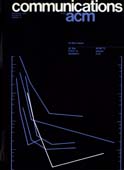November 1972 - Vol. 15 No. 11

Features
A comparative study of computer programs for integrating differential equations
Algorithms to reveal properties of floating-point arithmetic
A highly parallel algorithm for approximating all zeros of a polynomial with only real zeros
A model for type checking: with an application to ALGOL 60
Derived semantics for some programming language constructs
Garbage collection for virtual memory computer systems
An approximate method for generating symmetric random variables
A note on optimal doubly-chained trees
Further comments on Dijkstra’s concurrent programming control problem
Comments on Moorer’s music and computer composition



